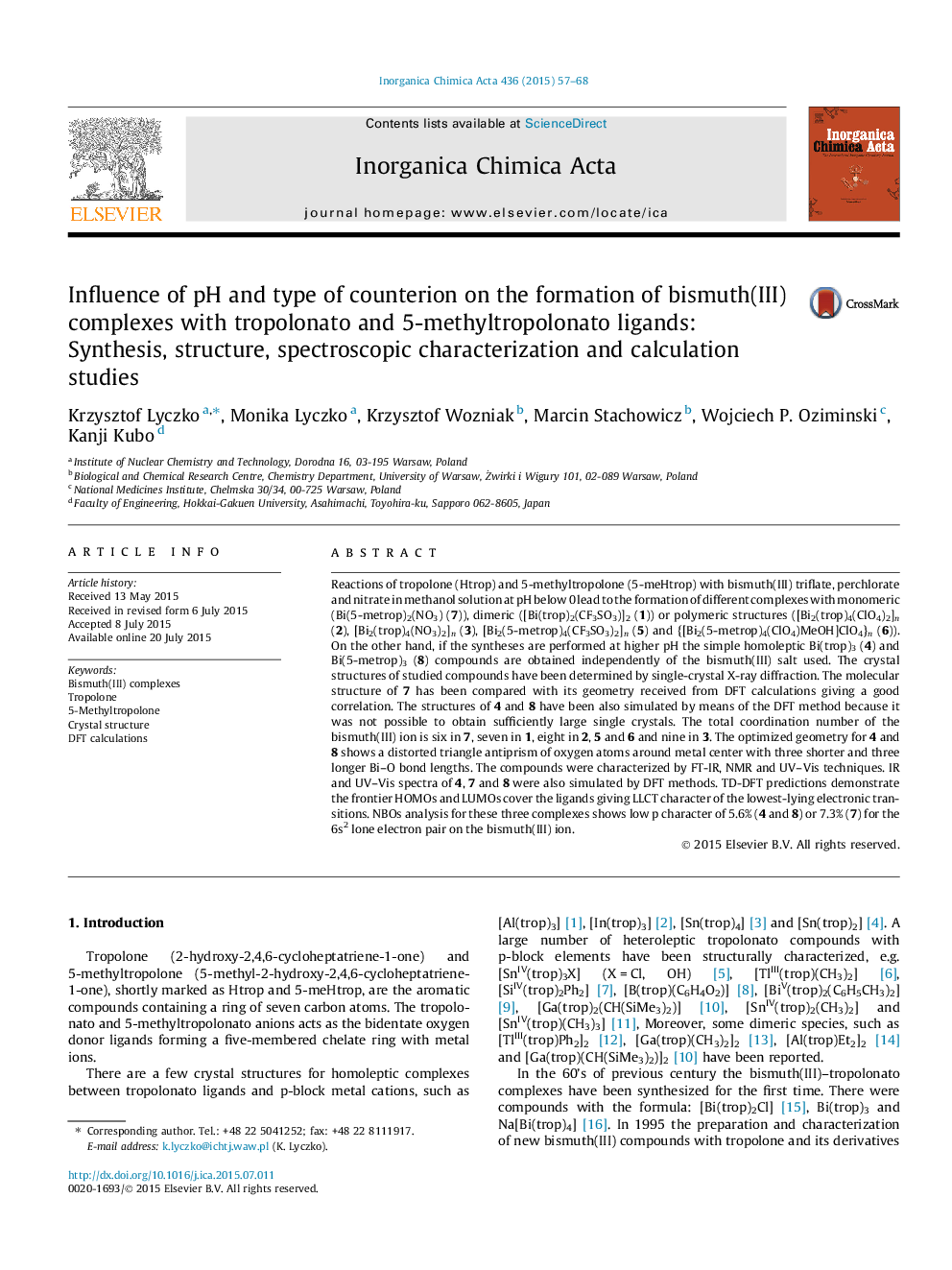| کد مقاله | کد نشریه | سال انتشار | مقاله انگلیسی | نسخه تمام متن |
|---|---|---|---|---|
| 1307627 | 1499153 | 2015 | 12 صفحه PDF | دانلود رایگان |

• Six heteroleptic Bi(III) complexes with Htrop and 5-meHtrop were prepared at pH <0.
• Two homoleptic Bi(III) complexes with these ligands were obtained at pH ∼4.
• The structures were determined by X-ray diffraction or optimized by DFT calculations.
• Spectroscopic characterization also with the use of DFT methods was carried out.
Reactions of tropolone (Htrop) and 5-methyltropolone (5-meHtrop) with bismuth(III) triflate, perchlorate and nitrate in methanol solution at pH below 0 lead to the formation of different complexes with monomeric (Bi(5-metrop)2(NO3) (7)), dimeric ([Bi(trop)2(CF3SO3)]2 (1)) or polymeric structures ([Bi2(trop)4(ClO4)2]n (2), [Bi2(trop)4(NO3)2]n (3), [Bi2(5-metrop)4(CF3SO3)2]n (5) and {[Bi2(5-metrop)4(ClO4)MeOH]ClO4}n (6)). On the other hand, if the syntheses are performed at higher pH the simple homoleptic Bi(trop)3 (4) and Bi(5-metrop)3 (8) compounds are obtained independently of the bismuth(III) salt used. The crystal structures of studied compounds have been determined by single-crystal X-ray diffraction. The molecular structure of 7 has been compared with its geometry received from DFT calculations giving a good correlation. The structures of 4 and 8 have been also simulated by means of the DFT method because it was not possible to obtain sufficiently large single crystals. The total coordination number of the bismuth(III) ion is six in 7, seven in 1, eight in 2, 5 and 6 and nine in 3. The optimized geometry for 4 and 8 shows a distorted triangle antiprism of oxygen atoms around metal center with three shorter and three longer Bi–O bond lengths. The compounds were characterized by FT-IR, NMR and UV–Vis techniques. IR and UV–Vis spectra of 4, 7 and 8 were also simulated by DFT methods. TD-DFT predictions demonstrate the frontier HOMOs and LUMOs cover the ligands giving LLCT character of the lowest-lying electronic transitions. NBOs analysis for these three complexes shows low p character of 5.6% (4 and 8) or 7.3% (7) for the 6s2 lone electron pair on the bismuth(III) ion.
Reactions of tropolone and 5-methyltropolone with bismuth(III) salts in methanol solutions of pH <0 lead to formation of compounds [Bi(trop)2(CF3SO3)]2, [Bi2(trop)4(ClO4)2]n, [Bi2(trop)4(NO3)2]n, [Bi2(5-metrop)4(CF3SO3)2]n, Bi(5-metrop)2(NO3) and {[Bi2(5-metrop)4(ClO4)MeOH]ClO4}n. At higher pH homoleptic complexes Bi(trop)3 and Bi(5-metrop)3 are formed. Structural and spectroscopic characterization was carried out, also with use of DFT and TD-DFT methods.Figure optionsDownload as PowerPoint slide
Journal: Inorganica Chimica Acta - Volume 436, 1 September 2015, Pages 57–68